Some things never go out of style. For centuries, mankind has engraved designs into surfaces to make a visual impression. From primitive tools, weapons, and pottery to turn-of-the-century print-, map-, and stamp making to contemporary drinkware, jewelry, and even medical devices, engraving’s creative and practical value remains timeless.

Cut, Carve, Create
The Engraving Methods Driving Personalization
By Stefanie Galeano-Zalutko
(Originally printed in the March/April 2025 issue of Insights.)
Some things never go out of style. For centuries, mankind has engraved designs into surfaces to make a visual impression. From primitive tools, weapons, and pottery to turn-of-the-century print-, map-, and stamp making to contemporary drinkware, jewelry, and even medical devices, engraving’s creative and practical value remains timeless.
Engraving has evolved significantly over the years, thanks to new technologies, materials, and consumer demands, according to Amy Harris, marketing communications specialist at Epilog Laser. Shifting from a handcraft to a precise, machine-driven art has given business owners expanded material options, greater consistency, and endless customization within the awards and personalization industry.
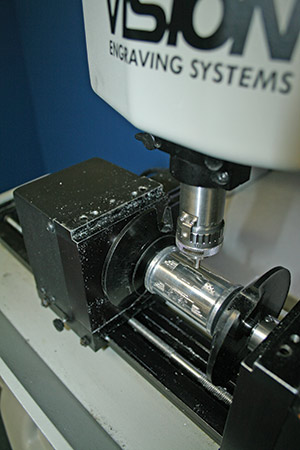 Photo courtesy of Vision Engraving & Routing Systems
Photo courtesy of Vision Engraving & Routing SystemsAs a result, the practice is not only more reliable and accessible, but also less time-consuming and more efficient than ever before—giving entrepreneurs more freedom to push the boundaries of imagination.
“Engraving offers permanent, high-quality marking on everything from inexpensive trinkets to extremely high-dollar items, making this process very attractive across the industry,” says Ron Zydonik, chief operating officer at Vision Engraving & Routing Systems.
Since there are few material constraints compared to other embellishment technologies, he says the possibilities with engraving are vast. In fact, the list of what you cannot engrave is far shorter than the list of what you can. And the technology continues to expand in material offerings like granite, marble, cork, and even thin-gauge materials.
“Your creativity is your only limit,” Zydonik says. “If you can hold it still and it fits into your machine envelope, then you can machine it, mark it, or cut it.”
Engraving brings the capabilities of everything from 3D marking, to deep part marking, to reflective faceted surface marking, and much more.
“Having the ability to cut, engrave, or mark everything from cardboard to steel, plastics to marble, synthetic materials to composite materials, and so on, gives owners tremendous market opportunities,” he says.
A plethora of applications and healthy profit margins are helping eager business owners turn an age-old practice into a modern marvel.
“Not having to turn away customer requests for personalized products of every shape and size has led to a resurgence of adoption of this technology,” Zydonik says.
There are many different kinds of engraving. Below, we cover some of the main ones used in the personalization industry.
Back to Basics: Rotary Engraving
Tried-and-true, rotary engraving is a machining process that transforms a material into different shapes, sizes, characters, symbols, and designs with a mechanical cutting tool or rotary bit and CAD/CAM-software assistance. At a basic level, rotary engraving uses physical contact to remove or scratch the surface of a material to create a contrasting mark, says Tom Tamburrini, president at Beam Laser Systems.
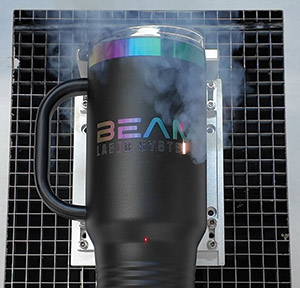
Photo courtesy of Beam Laser Systems
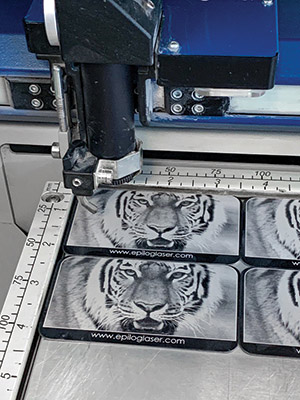
Photo courtesy of Epilog Laser
Over the years, industry professionals have turned to rotary engraving as a proven technique to mark various texts, shapes, and logos, as well as variable numbering and data. Despite the advent of more advanced technology like laser and UV, rotary engraving is still revered as a long-lasting and tamperproof option inclusive of various materials and possibilities—from perfecting deep metal engraving and professional ADA signage to handling warped, uneven material and creating beveled edges with ease.
In addition to permanently engraving plastics such as Plexiglas and ABS, rotary equipment is adept in paper, cardboard, leather, and much more with the correct attachments and tools.
“Rotary engraving is versatile in terms of the materials it can handle, particularly on metals, plastics, wood, glass, and acrylic,” Harris says. “But the technique is generally more effective on harder materials (like metal or stone) and may not be suitable for delicate surfaces.”
Though rotary engraving has its perks, Tamburrini and Harris agree rotary engraving is more limited in terms of fine lines and intricate patterns.
“The depth of the engraving is controlled by the movement of the tool and the force applied, which can sometimes result in rougher edges or variations in depth. While it can be controlled to some degree—and high-quality results can be achieved—complex or smooth finishes can be more challenging,” says Harris.
For other industry professionals, most of the perceived limitations associated with rotary engraving can be attributed to an operator’s comprehensive understanding, level of creativity, and overall skill.
“Ten people could have the same rotary machine and the same product to embellish and they can all submit a drastically different-looking finished product because rotary lends itself to a higher level of creativity and individuality of design and output,” Zydonik says.
In addition to their versatility and significantly more affordable price tags, rotary machines are built to last and produce some of the highest profit margins in the industry.
“If you do not have the [showroom] real estate or capital to own multiple pieces of [laser] equipment, then give rotary a strong consideration as it has the broadest range of capabilities,” Zydonik says.
New Horizons: Laser Engraving
Industry veterans credit laser engraving—a technology that uses a laser beam to vaporize material from a surface to create a desired design—as one of the most significant innovations in engraving history.
“The invention of the laser changed the industry, improving quality and engraving efficiencies, as well as [expanding] applications and the types of engravings that can be achieved,” Tamburrini says, touting the technology’s ease of use, speed, accuracy, and digital workflow.
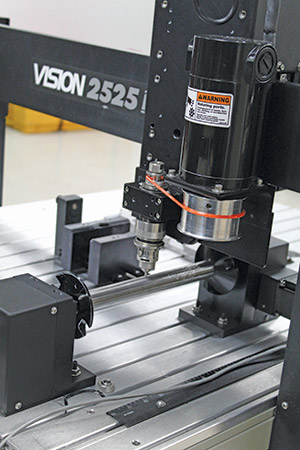 Photo courtesy of Vision Engraving & Routing Systems
Photo courtesy of Vision Engraving & Routing SystemsHarris praises laser technology for its more intricate, detailed, and precise designs compared to rotary engraving, especially as it relates to fine lines, small text, or complex graphics and patterns, which is especially useful in achieving uniformity for mass production.
“Precision and consistency allow for high-resolution engravings that are difficult to achieve with hand tools or rotary-engraving methods,” Harris says.
Two complementary sources are at the forefront of laser technology: CO₂ and fiber lasers. A CO₂ laser uses a carbon-dioxide-based gas mixture captured in a glass or metal cavity to generate the laser beam, while a fiber laser (a solid-state method) uses diodes and a fiber-optic lasing medium.
These lasers can accommodate hard and soft materials without compromising the quality of the engraving. Polyvinyl chloride, or PVC, is the lone exception, according to Harris, as the material can release corrosive gases that are harmful to the operator and the inside of the laser system.
Each laser source has its own wavelength, or color of light, so materials react differently.
A CO₂ laser can engrave and cut a variety of materials like wood, leather, acrylic, fabric, paper, rubber, and much more. While it cannot cut harder materials such as glass, anodized aluminum, slate, and marble, it can etch and mark these substrates. Fiber lasers excel at marking bare metals and engineered plastics but aren’t designed for cutting of organic materials. They can etch, polish, and anneal metal—achieving deep engravings with multiple passes—while CO₂ lasers can only create surface marks on treated metals.
Though there is some crossover usage, such as marking anodized aluminum, the lasers ultimately have different purposes. Thus, owning both CO₂ and fiber lasers allows a business to offer a broader palette of high-end, laser-engraved products.
“While laser engraving requires a commitment—to learning the machine and how to acquire customers and the realization that there is no one-size-fits-all solution to the problems that will be faced—the opportunities are plentiful,” Tamburrini says.
The Best of Both Worlds: Rotary Attachments
Most laser manufacturers have a rotary-
attachment option designed specifically for their machines. The rotary attachment is placed within the laser cabinet and used to engrave cylindrical items like wine bottles, mugs, and tumblers.
 Photo courtesy of Beam Laser Systems
Photo courtesy of Beam Laser Systems“This is generally sold as an optional accessory. It absolutely makes sense to make the investment so that your laser-engraving business can fulfill more customer demands right out of the gate. That way, you’ll have it if you need it and can use your laser for other purposes when you don’t,” Harris says.
While the Swiss Army–knife approach theoretically checks all the boxes, Zydonik reminds business owners to consider the pros and cons of their personal situations. Depending on the brand in discussion, an engraver may trade quality and reliability for versatility.
“Additionally, one of the biggest risks, of course, is that when you have an equipment breakdown or service issue, all your embellishment methods are down at the same time,” he says.
Everyone has their preference: Rotary machinery excels at 3D and dimensional marking, while lasers create visual contrast depending on the substrate. What is important to remember is lasers do not compete with CNC routers or rotary engravers.
“They are different tools for different applications,” Zydonik says.
Newly Improved: UV Laser
If rotary engraving is foundational and current laser technology is considered a gold standard, then is UV the future? Tamburrini says UV lasers as a highly effective and unique option available to the awards and personalization industry.
“As the name describes, it is in the ultraviolet end of the light spectrum, whereas CO₂ and fiber are in the near-infrared range. UV lasers are sometimes referred to as cold lasers since materials react through a photochemical reaction as opposed to superheating the surface by CO₂ or fiber sources,” Tamburrini says.
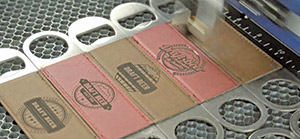 Photo courtesy of Epilog Laser
Photo courtesy of Epilog LaserThis process does not produce thermal deformation (heat damage) on the inner layers and nearby the target area. As such, UV lasers are ideal for engraving anything from Teflon and diamond to silicone and precious metals to fruit.
“UV is well suited for marking a wide range of items, such as metal, plastics, and especially crystal or glass,” Tamburrini says.
Industrial applications are popular with UV laser engraving as well, specifically as it relates to the traceability of bar- and QR codes. Highly heat-sensitive materials benefit from this wavelength, as used in the semiconductor industry.
While the UV topic is trending, it is anything but new. The method’s problem is not its capabilities. Rather, it has a former reputation as expensive and somewhat unreliable, especially at higher power levels. But Tamburrini says that’s changing.
“The technology has advanced, costs have come down, reliability has gone up, and power levels are increasing, as well,” Tamburrini says.
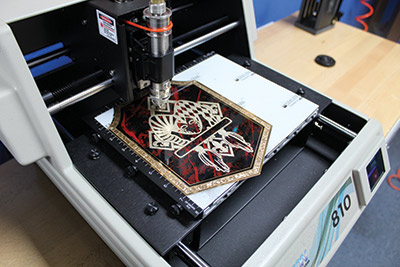
Photo courtesy of Vision Engraving & Systems
He suggests the UV-laser-engraving method to business owners who want to achieve differentiation across certain product types, but he cautions them to do their homework.
Though UV-laser-engraving technology boasts very low power requirements; top quality, accuracy, and versatility among delicate applications; as well as long maintenance-free periods, the technology is limited in application range, and therefore, costs can be a major consideration.
Equipped for Success
Customer choices continue to broaden as engraving technology becomes more sophisticated. But, before jumping into an investment, business owners are encouraged to take their time and evaluate different opportunities.
“Ask yourself what it is you plan to do and what type of customers you are intending to address—aim high,” Tamburrini says.
 Photo courtesy of Epilog Laser
Photo courtesy of Epilog LaserDefining the scope and extent of one’s business before purchasing equipment is important, Zydonik advises.
“It is easy to want to buy bigger equipment with more features and capabilities, or to buy the ‘latest and greatest,’ but you have to confine yourself to buying what serves you best for your specific products and markets, while providing room to grow,” Zydonik says.
Conduct deep-dive research on potential products, make a list of thoughtful questions, and request a full application-specific product demonstration from an established supplier with a five-star reputation.
“Develop your business plan for this technology, even if it is rough notes. Know what applications you want to start with, know where you want to grow your business, and be sure that the solution you pick will get you there—today and tomorrow,” Zydonik says.
Next, prepare the office space accordingly and allow enough room for workflow, as equipment could require between 2 square feet and 100 square feet.
In a tight market, entrepreneurs are reminded to tap into their strengths, differentiate themselves from the competition, and provide superior customer service.
“Walk before you run,” Zydonik says. “Ironically, one of our biggest challenges is to help the new equipment owner focus and stay within their business plan as a new engraver. As they begin to learn all that the equipment can do, it is easy to jump into a myriad of markets. You can lose focus as you try to serve too many channels at one time. So, we encourage you to use a controlled-growth logic with your business.”
Stefanie Galeano-Zalutko leads Zalutko Business Services, Inc., a
marketing agency based in central Florida. She can be reached at
szalutko@zalutkobusiness.com.
